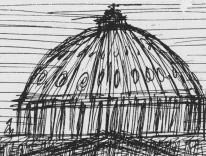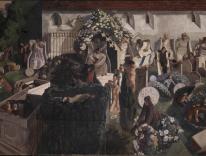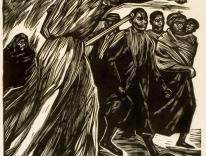Bishops were special. Cardinal archbishops even more so. It was 1954, the Marian Year. The place was Soldier Field, Chicago’s huge football stadium, and we were at the end of the Holy Name Holy Hour. The place was filled to capacity with thousands of devout Catholic men who had come to pray, sing, and, perhaps most important, show the Protestants of the World Council of Churches meeting at Northwestern University just how powerful the Catholics of Chicagoland were. It was a time of unapologetic triumphalism.
Being in the seminary choir, I was in a position to see Samuel Alphonsus Cardinal Stritch coming toward me, and suddenly realized he would pass within inches. It was my golden opportunity. As he passed, I could reach out, kiss his episcopal ring, and gain three hundred days indulgence! I could clearly see the huge emerald ring encrusted with diamonds. In a moment he would be near. But the stadium floodlights suddenly hit his pectoral cross, also made of large emeralds set in a frame of diamonds as it rested on his mantle of white ermine. I was blinded by the splendor of it and could easily have missed the moment, but I was not to be denied my indulgence. I grabbed his hand, bowed low, and kissed the great ring of the archbishop of Chicago, metropolitan of Illinois, and cardinal priest of the Roman Catholic Church. Yes, cardinals were very special.
Still my cup of joy was not yet filled. When the cardinal later came to the seminary at Mundelein, a trainbearer was needed to carry his twenty-foot train of scarlet watered silk. Since he was a short man, short trainbearers were required. I qualified. I was dressed in a miniature monsignor’s cassock of magenta wool, and when the cardinal ascended his throne in the sanctuary, I sat in attendance on the bottom step, making sure his long train was arranged suitably. Frankly, it was rather humiliating, and the source of much mocking by irreverent classmates. When, at Vatican II, cardinals were told to reduce their trains, one could only wonder what would happen to all that extra crimson. Still, cardinals were special.
Then came ordination and a closer look at bishops and cardinals. Except for ceremonial occasions, they had seldom been seen up close. Cardinal Mundelein, who styled himself "Prince of the West," built a large mansion, a copy of Mount Vernon, above his private lake at Saint Mary of the Lake Seminary. Even the nearby town changed its name to "Mundelein." In his black limousine with the number one license plate, he would be driven into Chicago in solitary splendor. He and his successors seemed quite princely. One of those successors, however, had a gift for alienating both rich and poor, black and white, young and old. While he reminded his priests that "I am the only successor of the Apostles in this diocese," he was ultimately under investigation by both the Chicago newspapers and the government. Fortuitously, he died just before he was indicted for financial malfeasance.
The demythologizing of the hierarchy was under way. Television, which could move in for a tight shot of a bishop’s face and mercilessly expose him as inarticulate or illogical, was not a friend. Catholic adults became weary of being treated like children. Many were now highly educated, even in philosophy and theology. While they did not expect their bishop to be as intelligent as Cardinal Newman, as courageous as Archbishop Romero, or as humble and insightful as Archbishop Camara, they were no longer willing to tolerate episcopal foolishness. When a Midwestern bishop excommunicated all in his diocese who attended Call to Action gatherings-meetings attended by other bishops-it was seen by many loyal Catholics as sheer nonsense.
American Catholics had given their church leaders a respect and obedience seldom found in Western Europe. They were willing to see their bishops as wise, noble, and good. But that has clearly changed. Trust can no longer be taken for granted. The action of bishops in Boston and elsewhere has given the final crushing blow. Now young Catholics, for whom Vatican II is as remote as the Council of Trent, find episcopal costumes and regalia curious and antique. More important, having been taught at university to question everything, to take nothing "on faith," they are quick to criticize pontifical pronouncements. Their parents are also asking difficult questions: "Just who is our new bishop? What are his qualifications? Has he had any real pastoral experience?" Most important, "Is he a man of prayer, a believer who is known for compassion and kindness?"
Saint Cyprian (d. 258) insisted that bishops be elected by the people. If certain prelates were to run for reelection today, they would never again preside from their cathedral thrones. Part of the sadness and anger so widely felt today is that a rather small group of priests and bishops has tarnished the reputations of so many. There have been and are now many bishops who meet Augustine’s definition, "servant" of God’s people. They have avoided pomp and pretensions, been honest and generous, and are men of prayer and integrity; they are pastors rather than hirelings. May their number increase. The myth of the supernal prelate, however, has been shattered. It will never be restored in the United States. Is that really so bad?


